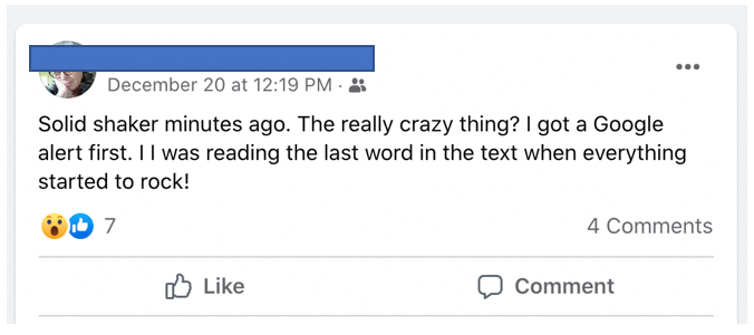My Facebook feed exploded shortly after noon on Dec. 20, 2021, with news from friends and family in northern California: A “big one!” The 6.2 magnitude earthquake they’d just experienced had its epicenter on the coast near Petrolia.
Yet many social media posts weren’t focused on the earthquake itself, but rather the alert sent to cellphones seconds before – or, for some, just as – major shaking began.

Lots of people justifiably marveled at the alert, but few seem to have taken advantage of it.
Facebook screenshot via Dare Baldwin, CC BY-ND
The ShakeAlert system is a remarkable technology, years in the making. It has the potential to save tens of thousands of lives in areas where high-magnitude earthquakes occur by providing a few seconds’ warning – enough time for people to take basic safety precautions. Marvelous as it is, though, ShakeAlert saves lives only if people understand what to do when they receive such an alert – and do it.
I’m part of an interdisciplinary group that includes psychologists like me and other social scientists, natural hazards experts, seismologists, geophysicists and communication and education specialists whose goal is to design earthquake preparedness and response systems that optimize safe outcomes. Some of us are working together to analyze video footage of various earthquakes posted to social media sites, such as Facebook, Twitter and YouTube.
Videos during the Petrolia-centered earthquake are the first we’ve seen of what people do – or don’t do – when they receive a ShakeAlert-powered alert. The footage suggests we have more work to do.

CCTV footage, like this still from video taken in Jakarta, Indonesia, during the 2004 earthquake, reveals how people really respond during shaking.
AFP/AFP via Getty Images
Detection and warning of imminent earthquakes
ShakeAlert depends on a massive network of seismic detectors distributed around the West Coast that pick up initial earthquake shaking.
For people near the epicenter, the time it takes to process the data and send an alert may mean it arrives just as, or possibly even seconds after, major shaking begins. Even this roughly simultaneous notice is valuable, as it helps people realize what is happening, which often isn’t obvious.
For those further away from a quake’s epicenter, an alert may arrive seconds, or even tens of seconds, before strong shaking. That’s enough time to automatically shut down or alter the operations of key systems – for example, to slow or stop trains, control equipment involved in delicate medical procedures, or electrical grids. It’s also enough time to prepare mentally, as well as to take potentially life-saving protective action.
To maximize your chances of coming out of a major earthquake alive and intact, most experts recommend in most cases – for California, Oregon and Washington – that you “Drop, Cover,…


